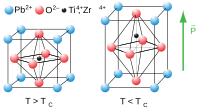
Photo from wikipedia
Abstract In the present work, the effects of temperature and frequency on the electrical transport properties of polycrystalline samples of Ba(1-x)Nd2x/3TiO3 (BNxT) (x = 0.00 and x = 0.04), prepared by molten-salt method, are… Click to show full abstract
Abstract In the present work, the effects of temperature and frequency on the electrical transport properties of polycrystalline samples of Ba(1-x)Nd2x/3TiO3 (BNxT) (x = 0.00 and x = 0.04), prepared by molten-salt method, are discussed. X-Ray diffraction reveals that all the samples crystallize in a tetragonal symmetry (space group P4mm) with the formation of nanoparticles. The crystallite size was found to vary around 40 nm. DC-conductivity measurements show and that all samples are characterized by a semiconductor behavior. The frequency dependent behavior of conductivity was well fitted in Jonscher's universal power law and interpreted in terms of Overlapping Large Polaron Tunneling (OLPT) mechanism. The Cole-Cole plot analysis of impedance spectra enabled to distinguish two relaxation behaviors assigned to originate from grains and grain boundaries. Besides, it was found that the electrical behavior of the ceramics is dominated by the grain-boundary response. Furthermore, the frequency dependence of electric modulus was studied and explained using Kohlrausch-Williams-Watts (KWW) model and the normalized M ″ / M max ″ spectra of the samples suggest that the distribution of relaxation times is temperature dependent and originates by the same mechanism. In addition, the conductivity and electrical response behavior in all the samples can be attributed to the long-range movement of oxygen vacancies.
Journal Title: Journal of Alloys and Compounds
Year Published: 2019
Link to full text (if available)
Share on Social Media: Sign Up to like & get
recommendations!